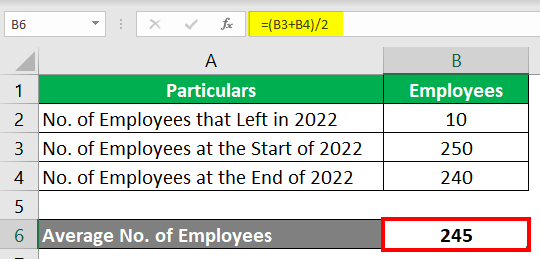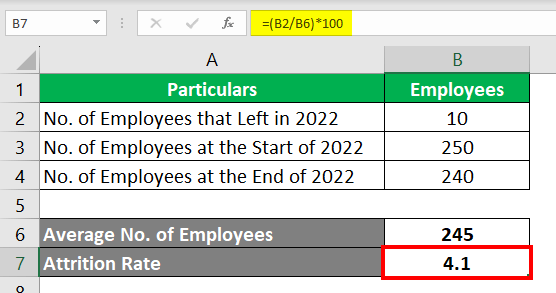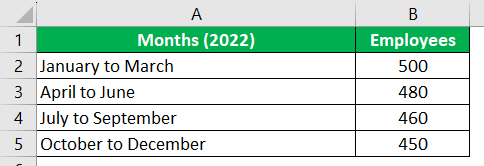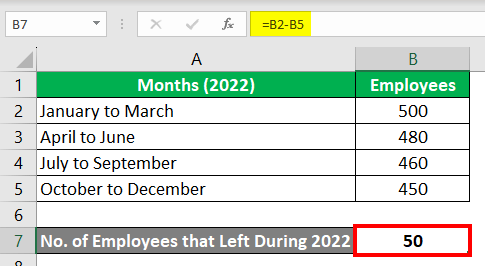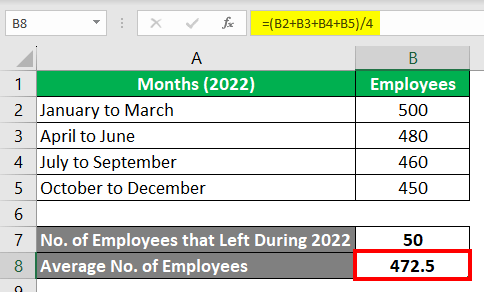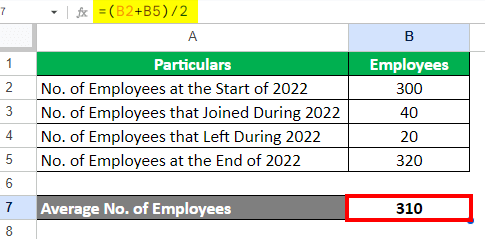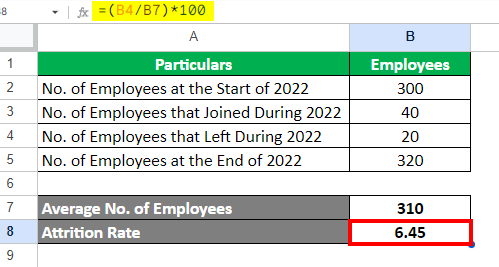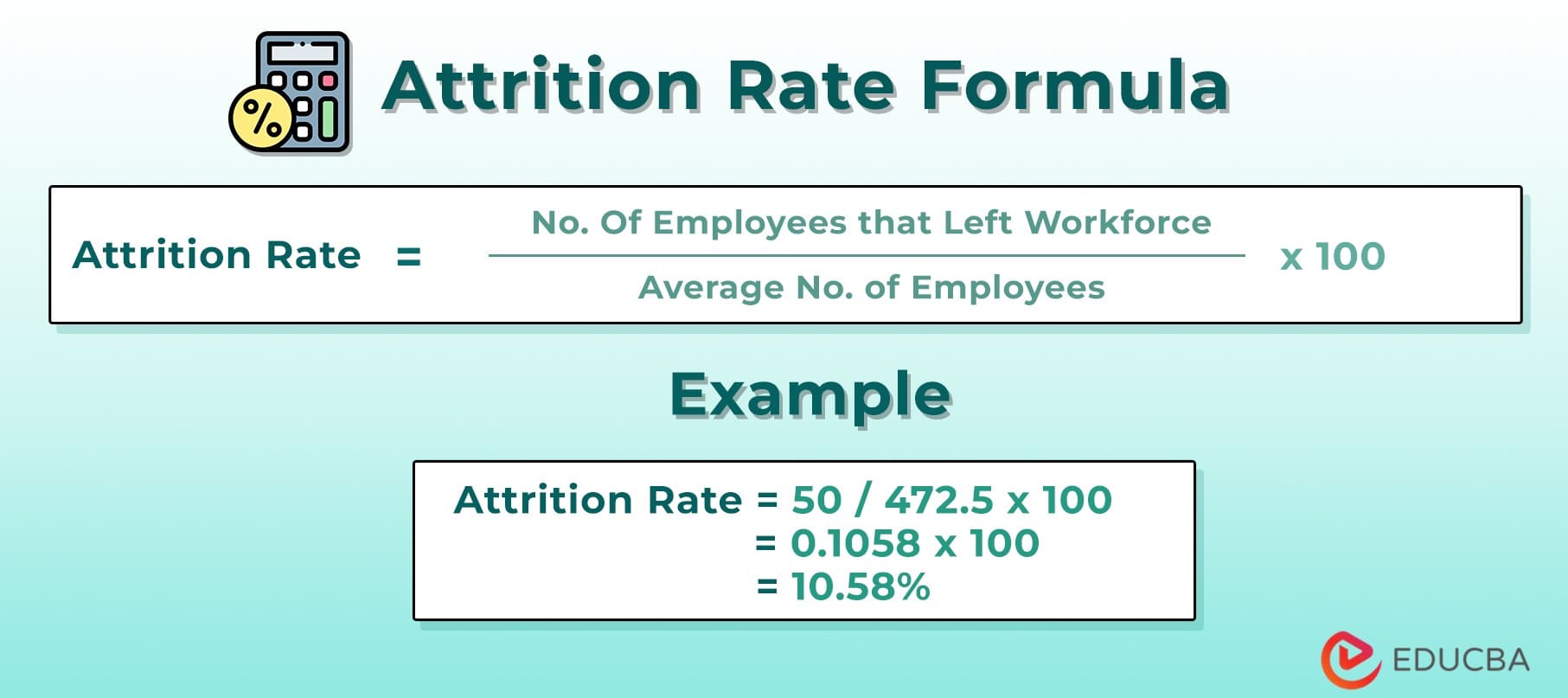
What is the Attrition Formula?
The attrition formula calculates the rate or percentage at which employees leave a job due to layoff or resignation over a particular period of time.
After the pandemic, employees are reconsidering their job preferences and looking for more satisfaction at work. They want flexible working hours as well as options like working from home. As a result, many companies are experiencing higher attrition rates. Therefore, companies must adjust their strategies and prioritize employee retention to stay competitive.
Companies can also use the attrition percentage formula to analyze how well they handle their employees and identify any problems in the management.
Attrition Formula
Where,
- No. Of Employees that Left Work: Total number of employees that left the job due to layoff, resignation, or retirement.
- Average No. of Employees = (No. of Employees at the Start of the Period + No. of Employees at the End of the Period) / 2
Total Employees at the Start + New Employees Who Joined – Total Employees Who Left.
Table of Contents
How to Calculate Attrition Rate?
Step 1: Find out how many employees the company had at the start of the period. (e.g., 1000)
Step 2: Find the company’s total number of employees at the end of the period. (e.g., 950)
Step 3: To compute the average number of employees, add the starting and ending employees and divide by 2. ((1000 + 950) / 2 = 975)
Step 4: Determine the number of employees who left the organization during the same period. (1000 – 950 = 50)
Step 5: Finally, use the attrition formula to calculate the attrition rate. ( (50 / 975) x 100 = 5.13%)
Attrition Formula in Excel (With Examples)
Example #1: Overall Attrition Rate
In 2022, a US-based IT company had 250 employees at the start of the year. However, by the end of the year, the employee count decreased to 240. Out of these 10 employees that left, the company fired 6, while 4 resigned. Calculate the company’s overall attrition rate for the year 2022 based on the given information.
Solution:
Step 1: Calculate the Average No. of Employees
Let us calculate the average number of employees working for the company in 2022.
= (250 + 240) / 2
= 245
Step 2: Find the Attrition Rate
Calculate the overall attrition rate using the attrition formula below,
Attrition Formula = (No. Of Employees that Left Work / Average No. of Employees) x 100
= (10 / 245) x 100
= 4.1%
The overall attrition rate of the company is 4.1%. This attrition rate includes both voluntary and involuntary departure of employees in the company.
Example #2: Voluntary Attrition Rate
A book publishing company analyzed the remaining number of employees every 3 months in 2022. They saw that many employees resigned during the year and wanted to find out how many employees left. The company did not hire any new employees this year. Use the below information to calculate the attrition rate for the year 2022.
Solution:
Step 1: Find the Total Employees That Left
Let us calculate the number of employees who left the company through voluntary resignations using the below formula,
= 500 – 450
= 50
Step 2: Find the Average Number of Employees
Next, calculate the Average No. of Employees using the below formula,
= (500 + 480 + 460 + 450) / 4
= 472.5
Step 3: Compute the Attrition Rate
Use the formula for attrition rate to calculate the percentage of employees that left the job.
Attrition Formula = (No. Of Employees that Left Work / Average No. of Employees) x 100
= 50 / 472.5
= 10.58%
The company had 500 employees initially but ended the year with only 450 employees. Therefore, the voluntary attrition rate is 10.58%. It means that 10.58% of the employees intentionally left the job in 2022.
Example #3: Involuntary Attrition Rate
Let us take an example of a shoe manufacturing company. The company had 300 employees at the start of 2022. During the year, they hired 40 new employees and fired 20 employees. Thus, the total employees by the end of the year were 320. Calculate the firm’s involuntary attrition rate for the year 2022 based on the given information.
Solution:
Step 1: Calculate the Average No. Of Employees
Average No. of Employees = (No. of Employees at the Start of 2022 + No. of Employees at the End of 2022) / 2
= (300 + 320) / 2
= 310
Step 2: Calculate the Attrition Rate
Attrition Formula = (No. Of Employees that Left Work / Average No. of Employees) x 100
= (20/310)x100
= 6.45%
The firm’s involuntary attrition rate for 2022 was 6.45%. The company removed 6.45% of employees in 2022.
Case Study: Why So Many FedEx Workers Are Leaving?
Source: bizjournals.com
FedEx, a delivery company, has been facing high attrition rates as many employees have left the company since 2019.
Below are the attrition rates at FedEx for the past four years:
FY 2019: Attrition Rate – 62%
FY 2020: Attrition Rate – 65%
FY 2021: Attrition Rate – 57%
FY 2022: Attrition Rate – 102%
This sharp increase up to 102% in the attrition rate means that many employees (530,932, as per sources) left the company in 2022. This number is higher than in 2021 when only 290,777 employees left.
The main reason for this issue is the part-time hourly employment system, especially for jobs like material and package handlers. People take these temporary employment opportunities, which means they frequently join and leave the company based on their contract duration. This constant turnover of part-time employees adds to the overall attrition rate at FedEx.
What Causes High Attrition?
- Inadequate compensation: Employees may feel they are not paid enough for their work and find better-paying opportunities elsewhere.
- Lack of career growth and development: When there aren’t many chances for employees to grow and improve in their current jobs, they start looking for other jobs.
- Poor work-life balance: Employees might feel emotionally and physically tired due to a lack of flexibility in managing their personal and professional lives.
- Inadequate management and leadership: Less communication, excessive micromanagement, and lack of support from managers can frustrate and dishearten employees.
- Limited recognition and rewards: Employees may leave due lack of acknowledgment and appreciation, which makes them feel unimportant and replaceable.
- Cultural mismatch: Some employees’ personal values and beliefs do not align well with the overall culture of their organization.
- Lack of job security: When employees are uncertain about how stable their jobs are, they worry about the possibility of getting laid off or facing financial instability within the company.
- Limited opportunities for feedback and involvement: The absence of channels for employee feedback and opinions can make employees feel undervalued and disconnected.
Other Types of Attrition
| Type | Description | Real-world Example |
| Internal | Employees who transfer or move to a different department or role within the organization. | Infosys introduced a “Bridge” program to retain employees by transferring them to a different department. |
| Retirement | Employees who leave the organization when they reach retirement age or want to take early retirement. | In 2022, the United States Public Sector (USPS) faced a shortage of workers due to a significant number of employees reaching retirement age. |
| Death | Employees who pass away while being employed by the organization. | A Navy candidate died during the US Navy training in February 2022. Although one death does not increase the attrition rate, deaths in dangerous occupations like defense can lead to high attrition rates. |
Attrition Formula Vs. Turnover Rate
| Particulars | Attrition Rate | Turnover Rate |
| Definition | It considers all employees who leave the company through voluntary resignation or involuntary termination. | It only includes employees who voluntarily decide to leave the company. |
| Calculation Method | The percentage of all employees who left (voluntary or involuntary) compared to the total number of employees. | The percentage of employees who left on their own compared to the total number of employees. |
| Company’s Response | The company may or may not hire new employees to replace those who left. | The company plans to find new employees to fill the positions left by those who chose to leave. |
| Benefits |
|
|
| Challenges |
|
|
Attrition Formula Calculator
You can use the following Attrition Formula Calculator
| No. Of Employees at the Start of the Period | |
| No. of Employees at the End of the Period | |
| Average No. of Employees | |
| No. Of Employees Who Left | |
| Attrition Rate = | |
| Average No. of Employees | (No. Of Employees at the Start of the Period + No. of Employees at the End of the Period) / 2 |
| = | (0 + 0 ) / 2 = 0 |
| Attrition Rate = | (No. Of Employees Who Left / Average No. of Employees) x 100 |
| = | (0 / 0 ) x 100 = 0 |
Frequently Asked Questions (FAQs)
Q1. What is the standard attrition rate?
Answer: Approximately 10% or less is the desirable attrition rate. However, this rate can vary depending on the specific challenges each company and industry faces.
Q2. Can attrition be more than 100%?
Answer: Yes, the attrition rate can be higher than 100% if more than 70% of the initial employees leave the job by the end of a period.
For example, a company has 60 employees at the start of 2022. If more than 70% of these employees,i.e., 42 employees, leave their jobs, then the turnover rate will be 108%.
Refer to the below image to understand the concept.
Q3. Can attrition be negative?
Answer: No, the attrition rate cannot be negative. It is calculated based on the percentage of people who have left the job. It is not possible for the “No.of people left the job” to be a negative number; it can either be 0 or a positive whole number. If nobody leaves the job, the attrition rate will be 0%. Hence, a negative attrition rate is not possible.
Recommended Articles
This is a guide to Attrition Formula. Here, we discussed the meaning, formula, and how to calculate the attrition rate with practical examples. We have also provided an Attrition Formula calculator and a downloadable Excel template. You may also look at the following articles to learn more –

